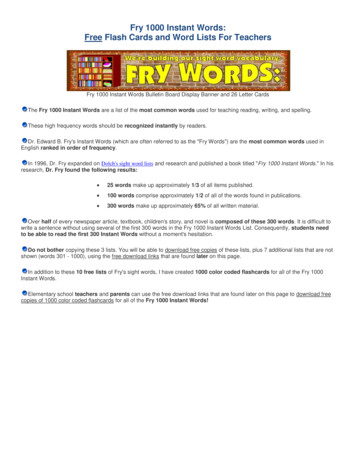
Transcription
The Complete Guideto Instant SpanishImmersionFluentU
Copyright 2014 FluentFlix LimitedAll Rights ReservedWe encourage you to blog, email, tweet and share this e-book withothers, but please don’t alter its contents when sharing. Thank you!www.Puentu.com
Contents1.Introduction1How to Immerse Yourself in Spanish When YouDon't Live Abroad2By: Rebecca Thering2.9 Great Resources to Learn Spanish Through theNews9By: Nick R.3.A Quick Guide to Learning Spanish Through Songsand Music15By: Elizabeth and Alan4.7 Best Movies to Learn Real Spanish23By: Elizabeth, Jason and Alan5.How to Learn Spanish with Facebook27By: Maureen Stimola6.5 Fun and ECcient Ways to Learn Spanish in YourCar33By: Jenny Marshall7.10 Tips for a Fun and Friendly Online SpanishLanguage Exchange39By: Maureen Stimola8.How to Learn Spanish with Pinterest46By: Maureen Stimola9.The Do's and Don'ts of Spanish LanguageImmersion AbroadBy: Maureen Stimola53
Learning Spanish is an exciting endeavor that can change your life byexposing you to new cultures, people and places. Furthermore, speakingSpanish undeniably opens an array of new doors for you in terms ofemployment.But in order to reap these beneXts, Xrst you need to learn the language.So what’s the best way to soak up the most Spanish in the shortest amountof time? Immersion.Now, we know that few have the time and money to simply hop on aplane and head to the nearest Spanish-speaking country right away, andthat’s exactly why we’ve put this guide together for you.There are so many useful ways, tools and tricks to immerse yourself inSpanish right now, no matter where you currently live.Let’s get started – instant Spanish immersion is but a page turn away!
[1]How to Immerse Yourself in SpanishWhen You Don't Live AbroadBy: Rebecca TheringImagine you’re in Madrid, Spain.You hear a celebratory roar erupting from the street, like nothing you’veheard before, as the whole city seems to be watching the same soccergame. “Vamos, vamos, vamos gol!”You’re late, on your way to watch said game at a bar with friends. Thethought of the fried, salty patatas bravas and refreshing, cold cañas thatyou’ll soon consume is making your mouth water.The stairs to the metro aren’t far, and once you’re down on the platform,joy ensues as the words “El próximo tren llegará en 1 min” (The next trainwill arrive in one minute) Yash across the screen in neon green letters.
FluentUBeing in Madrid, you are constantly surrounded by Spanish. Every dayyou hear, read, write and speak it, without going out of your way to doso. Through immersion, you’re learning Spanish faster than you ever havebefore.But we can’t all be in Spain right now. Nor Chile, Honduras or Argentina.So how can you immerse yourself in Spanish when you don’t liveabroad?How to Immerse Yourself in Spanish When You Don’tLive AbroadChange Your Digital Language Settings to SpanishGo into your Facebook settings and change the language to Spanish.That’s how I learned the word “muro” (wall) back in high school. Then gointo your email account – and any other online accounts that you interactwith daily for that matter (Twitter, Reddit, Pinterest, etc.) – and do thesame: change the language to Spanish. Next grab your digital camera, cellphone, iPad, computer, GPS, Kindle – any piece of technology that youown – and head to the language settings. These changes will get youthinking in Spanish when you otherwise wouldn’t, and you are sure tolearn new words.Read Spanish Newspapers OnlineIf you regularly check the news online, start reading it in Spanish. Mypreference is the Madrid-based El País, since I grew fond of it during thetwo years I lived in Spain, but there are a number of other Spanish newssources available online. Here are a few to get you started: CNN en español Google News España BBC Mundo3
4The Complete Guide to Instant Spanish Immersion ABC El Nuevo HeraldChoose one and set it as your new homepage today. For smartphone users,most of these newspapers have free apps to download, as well. And to getthe most out of your time reading the news, this post with 9 great tips forlearning Spanish with the news is a must-read.Read Children’s Books in SpanishGo to your local public library and head to the foreign language shelf inthe children’s section. If you’re more advanced, pick a young adult favoriteand see if your library has it in Spanish (Harry Potter, anyone?). Alreadyknowing the plot will help you understand what’s going on as you read inSpanish.As a Kindle owner, I also like to browse Amazon’s free Spanish e-booksfrom time to time. Reading books in Spanish on my Kindle is greatbecause with a Spanish dictionary installed, Spanish deXnitions of appearon the screen at the tap of a Xnger. Many public libraries have digitallibraries now too, so that’s another place to check for Spanish e-books.Label Items in Your HouseI’ve done this multiple times, when learning both Spanish and French,to master household vocabulary. I simply wrote Spanish words on smallYashcards, and then taped each to its corresponding item in my apartment.Both times I had roommates who were much less excited than I was, butultimately they let the labels stay up for a few weeks. Staring at “ventana”every time I looked out of the window while doing dishes, or seeing“enchufe” on the electrical outlet took advantage of my visual learning styleand got those words ingrained in my brain. Grab a marker, tape, somepaper and get started!
FluentUListen to Spanish RadioListening to Spanish music on the radio while you’re driving, workingout, or simply at home is another great way to immerse yourself inSpanish. My favorite Spanish radio station is Cadena Dial (97.1 FM inMadrid), which plays Spanish music all the time. You can listen to CadenaDial en directo (live) online here.If you discover a song that sticks with you after listening, use FluentU tolearn the words and meaning. Once you’ve practiced and studied it for abit, play Lyrics Training to see how well you know the song.Here’s a quick guide to learning Spanish through songs and music for yourreference.Mix it up and try listening to a talk radio show from time to time. To getaccustomed to hearing castellano from Spain, I recommend Cadena Ser.Listen to Spanish PodcastsSimilar to Spanish radio talk shows, you can easily Xnd free Spanishpodcasts online. Sure, there are many podcasts made speciXcally forSpanish learners, but you can also listen to podcasts produced by nativeSpanish speakers about a wide variety of topics. Where can you Xnd thesepodcasts?Go to the iTunes Store and scroll all the way to the bottom of the screen.In the fourth column, Management, select “Change Country”. Chooseany Spanish-speaking country that you want, and then scroll back up andclick “Podcasts”. Then comes the fun part: Browse through the variouscategories and “top podcasts” from that particular country, and listen to apodcast that looks interesting to you.Keep an Agenda or Journal in SpanishI’ve always kept some sort of journal, but it wasn’t until I Xrst lived in Spain5
6The Complete Guide to Instant Spanish Immersionas a study abroad student that I began to journal in Spanish. Writing inSpanish about your thoughts and everyday activities is a great way to honethe skill, even if you’re a beginner. My private thoughts also feel like theyhave an extra layer of protection when they’re written in Spanish!If you keep an agenda/planner or any sort of calendar, start writing yourappointments and events in Spanish.Watch Spanish TelevisionI usually feel a bit guilty when I spend time watching TV, but deXnitelynot when it’s in Spanish. That’s a mental workout! Many Spanish TVshows can be watched online, and will usually be divided into threecategories: series, programas, and noticias. Series are Xctional television series;programas include talk shows, documentaries, cooking shows, reality TVand game shows; while noticias are news segments. Two more helpfulwords when navigating these sites are “capítulos” (episodes) and“temporada” (season). Here are a few Spanish television channels to get youstarted: Antena 3 RTVE Televisión Cuatro Tele Cinco La SextaWatch Spanish MoviesWhile many Spanish TV shows can be found online, don’t forget aboutyour public library when it comes to movies! I love getting DVDs fromthe library because it’s easy to add Spanish subtitles from the main menu.Most foreign language movies that you can stream or watch online willhave English subtitles, which is not recommended when you’re learninga foreign language. Why not? Your mind will be reading all of the
FluentUEnglish and not listening to the Spanish. It takes great concentration tolisten – especially in a foreign language – so if your eyes can read theSpanish while your ears listen to it, you’re setting yourself up for successfullearning through immersion.Check out these eight useful tips for learning Spanish with movies, whichalso includes some movie suggestions. Then, here are seven more greatmovies for learning real Spanish.Join a Spanish Conversation TableThe only way to get better at speaking Spanish is to speak Spanish. Irecommend joining a Spanish conversation table to be surrounded byother Spanish speakers. Search Meetup, Craigslist (Community), andFacebook groups to Xnd an existing Spanish conversation group near you.Not having any luck? Start your own group! Advertise in the same siteslisted above, and then put up a few Yyers around town. You could trylooking for a one-on-one language exchange (intercambio) too, if youlike. And remember: Talk a lot and make tons of mistakes, and then talksome more.Work at a Spanish-speaking RestaurantMy good friend worked at a Qdoba during part of college, and he gotto speak Spanish with the kitchen staW every day. No Spanish skills wererequired when he applied for the job, but he was surrounded by Spanishwhile working and picked up lots of slang. If you have time for a part-timejob, why not consider working at a restaurant where Spanish is spoken bysome of the staW or owners?Volunteer with Spanish SpeakersLook for volunteer opportunities with Spanish speakers. One semester Ivolunteered as a childcare assistant for Spanish-speaking children whiletheir parents were in free ESL classes. Playing with the children was a low-7
8The Complete Guide to Instant Spanish Immersionpressure way to use what Spanish I knew, while being immersed in thelanguage. Here are four useful sites for Xnding volunteer opportunities: Craigslist (Volunteers) Idealist United We Serve Volunteer MatchWatch Spanish Videos on FluentUFinally, a great place to access authentic Spanish videos online is righthere at FluentU. FluentU has put together a collection of the best realworld Spanish video content from the web, and all of the videos canall be watched with Spanish subtitles – score! The videos types rangefrom commercials and music videos to funny homemade mini-moviesand speeches – so no matter your interests or level, you’ll Xnd somethingexcellent to watch.Even when you’re not living abroad, you can clearly still take manymeasures to immerse yourself in Spanish. So kick that Spanish learninginto high gear and use these tips to soak up all the Spanish that you can.There will always be partidos de fútbol and patatas bravas waiting for you inSpain; they’re not going anywhere.
[2]9 Great Resources to Learn SpanishThrough the NewsBy: Nick R.Learning Spanish shouldn’t be a chore.One of the keys to successfully learning Spanish is Xnding ways tocombine your passions with your language practice.For example, if you like movies, you can learn Spanish with classicArgentine movies.Or if you like music, popular Spanish songs are a no-brainer.And if you’re a news addict, learning Spanish through the news (orSpanish podcasts) is a perfect addition to your Spanish study routine.
10The Complete Guide to Instant Spanish ImmersionHow do you know if you’re a news addict? Do Xnd yourself refreshing theBBC homepage multiple times per hour? Do you get the shakes at the ideaof being the last one to know about a major world event? Do you havemultiple favorite world leaders? These are all signs of a serious news habit.Other Reasons to Learn Spanish with the NewsAnother important key to learning Spanish is regular practice. If youalways start your day with a dose of news over breakfast or coWee, or Xnishit by watching the nightly news over dinner, you have a guaranteed halfhour language learning slot just waiting to be Xlled with Spanish news.News is a great way to build useful vocabulary. Unlike works of Xctionor even Xlms, the vocabulary used in news is highly formulaic, meaningyou won’t have to worry that learning the words for basket-weaving(cestería) or windshield wipers (limpiaparabrisas) will Xll up valuable Spanishvocabulary space in your brain. This gives you more opportunities to learnindividual words, as well as conXdence that the words you do learn will beuseful.For those who aren’t super interested in the news, this list includes a fewalternatives that break with the serious, detached approach to journalismof mainstream media companies.Tips for Learning Spanish Through the NewsLearning Spanish through the news is not diZcult. Beginner Spanishlearners may want to start with a news website that oWers both Englishand Spanish versions of major news stories, such as El País or the MiamiHerald (Nuevo Herald). Some simple tips to get the most out of yourpractice include: setting yourself a target of at least one article per day,keeping a notebook with the words you translate each day, and revisingthis notebook after each news reading session, and again at the end of eachweek.
FluentUThe most important thing is to Xnd a news source that actually interestsyou. You don’t have to be addicted to world news to get somethingout of reading Spanish news. There are 460 million Spanish speakers inthe world. With a market that large, you can be sure there is a Spanishlanguage publication for every interest. There are Spanish motormagazines, fashion magazines, celebrity gossip magazines, there’s even aSpanish magazine for train enthusiasts (Revista Tren if you’re interested).Best of all, there is absolutely no reason to worry about highbrow content.In fact, when you’re starting out, the lower the brow of your content thebetter. Simple vocabulary and short sentences are exactly what you wantto aim for as a beginner. For best results, combine reading and listeningcomprehension through print and TV or radio news.You may want to try summarizing news articles in a few short (Spanish)sentences after you’ve Xnished them. This gives you an opportunity toreinforce the vocabulary you’ve just learned, while practicing your Spanishgrammar and sentence structure. If, however, you Xnd this technique turnsyour reading practice into such a chore that you Xnd yourself makingexcuses to avoid it, deséchalo (throw it out)! We’re aiming for quantity andthe surest route to quantity is maintaining your continued interest.If this all sounds like a lot of work, you might want to consider learningSpanish with news videos on FluentU. FluentU has gathered together theweb’s best Spanish videos — like news, commercials, movie trailers, andmusic videos — and changed them into language lessons. If you wantto take it easy, you can watch the videos with transcriptions underneath.You can hover over any word to look it up. FluentU’s “Learn Mode” alsoconverts every video into a quiz which tests you based on video context.9 Great Resources for Learning Spanish with the NewsNoticias Google (Google News in Spanish)Google News’ Spanish Service aggregates content from news mediaaround the world into a scrolling list of articles organized according to11
12The Complete Guide to Instant Spanish Immersiontheme. The site includes a variety of customization options to increase ordecrease the presence of a certain media provider, region, or theme, inyour news feed.El PaísEl País is a major metropolitan daily paper based in Madrid, Spain. The siteoWers three portals – Spain, America (including Latin America), and Brazil(coverage in Portuguese) – which Xlter content according to region. Thecoverage is of an excellent quality. El País also oWers an English portal withtranslations of a small selection of articles featured on the main page. Thismakes it a good option for beginning Spanish learners, as these articles canprovide a good Xrst step into Spanish news.News in Slow SpanishNews in Slow Spanish is the deXnitive resource for beginning Spanishlearners who wish to improve their comprehension. The two hosts goover a selection of news items from the past week at approximately threequarters of normal reading speed. This may sound strange, but forintermediate students of Spanish this little bit of extra time is all that isneeded to dramatically boost comprehension.Radiotelevisión Española (RTVE)Radiotelevisión Española is Spain’s national public broadcaster. RTVE’s ala carta (on the menu) service allows viewers from all around the worldto select from its programming list. This includes a variety of news andcurrent aWairs programs such as Informe Semanal and the Telediarios. Thisis probably the best option for those of you who prefer to watch a solidhalf hour of news over dinner every night.SBS Spanish NewsThe website of the Australian Special Broadcasting Service includescontent in Spanish in a variety of formats. These include: print news inSpanish, as well as a collection of short news radio programs focusing on
FluentUAustralian and international news. For Australian viewers, SBS also oWersan on-demand viewer for their daily, 1 hour Spanish TV news.ESPN FootballYou don’t always have to read serious news! Football is a huge part of theculture all across the Spanish-speaking world. If you’re learning Spanishto talk to Spanish people, you’re going to need to learn how to talk aboutfootball. You can Xlter your results by country and by region, if you’reinterested in travelling to a particular region, or are already a fan of aSpanish team.JuxtapozJuxtapoz is an arts and culture magazine with its origins in the lowbrow artscene of 1990s Southern California. Juxtapoz’s Spanish language editioncontinues to feature lowbrow and alternative art forms such as street artand poster art; however its focus is more international, with a great dealof art from Spanish and Latin American artists. If you’re passionate aboutart, Juxatpoz is the perfect way to introduce yourself to the art scene in theSpanish speaking world.VogueVogue is the most prominent publication in fashion. The Spanish editionof Vogue was started only a few years after its American counterpart, andis every bit an equal in the depth and quality of its coverage. This includescoverage in a variety of media, including short videos. This makes it agood mixed-media platform for those looking to increase their listening,as well as reading, comprehension.ViceVice publishes three Spanish editions: Spain, Mexico and Colombia,though there is substantial content overlap between the three. The editionsfeature Vice’s distinctive style of journalism: focusing on marginal13
14The Complete Guide to Instant Spanish Immersioncharacters and themes, and many stories written with a Gonzo approachto journalistic immersion.Vice has recently moved into covering major news stories; however, theapproach of their journalists is unlike mainstream news media, and maybe very popular among people who don’t Xnd major news providersappealing.
[3]A Quick Guide to Learning SpanishThrough Songs and MusicBy: Elizabeth and AlanWe’ve all been there.Sitting painfully through traditional Spanish language classes.Desperately trying to memorize vocabulary.Thankfully there are less conventional and more fun ways to learn Spanish.Like learning Spanish on YouTube. Or learning Spanish throughmovies and Spanish podcasts.And of course, by learning Spanish through songs.
16The Complete Guide to Instant Spanish ImmersionWe all get songs stuck in our heads – so put that to good use and use it asa learning tool to improve your language skills!Why Learn Spanish Through Songs and Music?Songs get stuck in our heads because of our brains. Music activates theauditory cortex part of our brains, and when we do not know the entiresong our brains Xll in the missing gaps in the rhythm and repeat it overand over. Scientists call this phenomenon a cognitive itch or a brain itch,and by repeating a tune in your head you are scratching the itch.Unfortunately, our brains sometimes act like stuck iPods, unable to shu[epast the song they are stuck on to move onto something else we wouldrather listen to! Scientists and researchers all around the world havediWerent names for songs getting stuck in our heads and diWerent theoriesfor why this happens.Marketing agencies and commercials are constantly coming up with newjingles and tunes to make their product memorable to you by creating asound or piece of music that will get stuck in your head, and often times itworks very well!We can use these same ideas to help learn a new language: If your braincan remember the music from a commercial or the theme song from apopular show on television, it will also remember a song or chorus linethat you have heard even if it is in a diWerent language.Why Are Songs Helpful for Learning Spanish?Learning a new language is hard – oftentimes sitting in a classroomis boring, learning from a textbook feels like work, and there is notmuch interaction with the real Spanish language and culture. By learningSpanish through songs your brain makes the connection between themusic you are listening to and the words and language concepts you aretrying to learn.
FluentUMusic allows you an insight into the Spanish culture that cannot be learnedfrom a book. You get to learn what people are singing about and thereforelearn more about the culture, opinions and activities of Spanish speakers.In addition, listening to music is fun! Singing along to Spanish music notonly increases your vocabulary and knowledge of popular Spanish culture,but will allow you to even out your accent and grow acquainted with localslang.Tips for Learning Spanish Through Songs and MusicAs mentioned above, we get songs stuck in our head all the time. If youlisten to something long enough you will begin to recognize the beat,beginning notes and lyrics of the song. With repetition you will soon Xndyourself singing along almost without trying! However, in order to learnSpanish eWectively, there are some tips and tricks to utilizing songs andmusic to your language-learning beneXt.Choose songs with clear pronunciation: If you Xnd a song has lyricsthat blend together or are hard to understand, consider picking a diWerentsong or reading the lyrics while you listen. For beginners, choosing simplesongs with clear lyrics, choruses and verses will assist you in learningSpanish much better than more complicated songs.Catchy beat: If the beat and rhythm does not catch your fancy when youlisten to it, you probably will not want it stuck in your head. Songs thatmake you tap your foot and bob your head are the best!Repeating chorus/verses: The best songs to learn Spanish are ones thathave repeating phrases in the chorus or verses that contain the same lyrics.If you can recognize and remember the lyrics you will be able to sing it inyour head with more accuracy!A familiar song dubbed in Spanish: Learning completely new songs inSpanish can be diZcult, so sometimes it is more than acceptable to take afamiliar English song and Xnd a Spanish version of it. You can do this for17
18The Complete Guide to Instant Spanish Immersiontheme songs, your favorite songs, or listen to familiar artists who also singin Spanish (like Shakira or Enrique Iglesias).Regional Spanish music: Pick songs sung by artists from the Spanishregion of the world whose dialect you are learning. Dialects across theSpanish-speaking world diWer and can use diWerent slang, so make it easyon yourself at least at the beginning!Look up unknown words: It’s also helpful to look up words that you’renot familiar with, and to write them down and periodically review them.Use FluentU: If this sounds like a lot of work, you can always use FluentUto learn songs. FluentU lets you learn Spanish through the web’s bestSpanish music videos. All lyrics are translated, and you can hover over anyword or phrase to see the translation. You can even review the words ina review session that uses video context to help embed the words in yourmemory.Getting Started with Learning Through Spanish SongsIf you are set to start to learn Spanish through songs here are a few goodones to start with. These artists cover a variety of Spanish genres, styles,beats and messages, so you should be able to Xnd something you like.In order to get the most out of these songs, here are a couple tips for whenyou listen. The Xrst time through, just listen to the song and the beat andtry to pick out any familiar words you might already know.The second time you listen, pay attention to any repetition that mightoccur in the song.And the third time, see if you can spot any unfamiliar words to look up.It will be incredibly helpful to keep a dictionary nearby, as well as havingthe lyrics available to look at. Make sure to also be in a place where youcan really pay attention to the songs; being distracted will not be helpful.
FluentUBecome familiar with these songs and soon you will Xnd yourself singingalong!1. Julieta Venegas – “Me voy”This song uses common Spanish words along with a slow, easy beat –which is perfect for Spanish learners. You’ll be able to recognize themajority of the words and the conjugations of the verbs without too muchtrouble. The song tells the story of a woman who leaves her lover and mustsay goodbye, even though she doesn’t want to.2. Café Tacuba – “Eres”“Eres” also has a steady, slow rhythm with simple, clearly articulatedwords that are easy to follow. The song is a love song demonstratingthe incredible joy of being in love, waking up next to someone, and nothaving to miss their presence anymore.3. Jarabe de Palo – “Bonito”You will tap your feet and bob your head to this song! It has a verycatchy beat and a repeating chorus line that you will be able to learn easily,and the lyrics are beautiful (much like the title). This song talks aboutthe beauty to be found everywhere in life, and that the bad things thatinevitably happen cannot take away from the overall glory of life. This isa great song for a rainy day!4. Juanes – “Nada valgo sin tu amor”Another love song, this smooth and easy jazz-inspired tune tells the storyof a man who is nothing without his lover. It is a beautiful confessionof a man who is in love and knows what he would lose without it: thewonderful feelings of companionship that comes with a relationship, andthe desire to feel that again when love has gone away.19
20The Complete Guide to Instant Spanish Immersion5.Marc Anthony – “Vivir mi vida”This song poses the question, “Why cry?”. Life is full of ups and downs,but excitement is all around and the only thing we can do is live our lives.Marc Anthony provides a very upbeat song you won’t be able to resistdancing to. Laugh, dance, shout, enjoy and live in the moment! This songis a reminder that the moment is all we have, so take advantage of it.6. Ricardo Arjona – “La historia de un taxista”This song tells the story of a taxi driver who picks up a woman on theside of the road. She is crying and he asks why. She says she has justbroken up with her boyfriend because he cheated on her. She and thetaxi driver begin speaking and telling their life stories. The taxi driverwonders, “What am I doing here, driving a taxi, speaking with thiswoman, thinking these terrible things?”. They decide to go to the barwhere her ex-boyfriend is and Xnd the taxi driver’s wife in his arms;from that night on the taxi driver and the woman meet at the corner andcontinue their relationship.7. Shakira – “No”Shakira’s “No” is slow and steady, and heartbreakingly expresses herreasons why she refuses to be with someone who is constantly causing herpain. She says that no one can live with the venom of this relationship,and that she resents the fact that her lover can still hurt her even when heis long gone. The lyrics are simple and powerful, perfect for learning avariety of new words.8. El Patio de Tu Casa – “Nuestros tiempos verbales”This song is perfect for utilizing new conjugations and learning newwords, combining life lessons and grammar tenses. You’ll receive a newand clearer understanding of Spanish grammar concepts like gerunds,subjunctive and inXnitives, as well as lyrical practice with all of the tenses.
FluentU9. Gloria Trevi – “Todos me miran”Look no further for the perfect Spanish woman power anthem! Fromthrowing oW the chains of her inattentive partner to becoming the queenof the city in an evening, Gloria Trevi’s passion is palatable through themusic she has created. You’ll dance, sing, and be inspired by the sequinsand spotlights that shine from this song, and in the end everyone will loveher!10. Jesse & Joy – “¿Con quién se queda el perro?”A sad and realistic breakup song, Jesse and Joy pose the question “Whogets the dog if we break up?”. What starts oW as a shiny, new and excitingrelationship Xlled with shared joys soon turns ugly. The song leaves uspacking bags and splitting material items until the Xnal question of whogets the dog remains. Devastatingly sad but all together relatable, this songwill allow you to learn new vocabulary while also being able to hear somewords you may already know well.Great! What Next?Now that you have a good place to start, you have the tools to Xndnew Spanish artists you like and play around with diWerent genres ofSpanish music. Find songs you enjoy listening to, Xnd others like them,and remember to keep a dictionary with you while you listen so you canlook up any
As a Kindle owner, I also like to browse Amazon's free Spanish e-books from time to time. Reading books in Spanish on my Kindle is great because with a Spanish dictionary installed, Spanish deXnitions of appear on the screen at the tap of a Xnger. Many public libraries have digital











